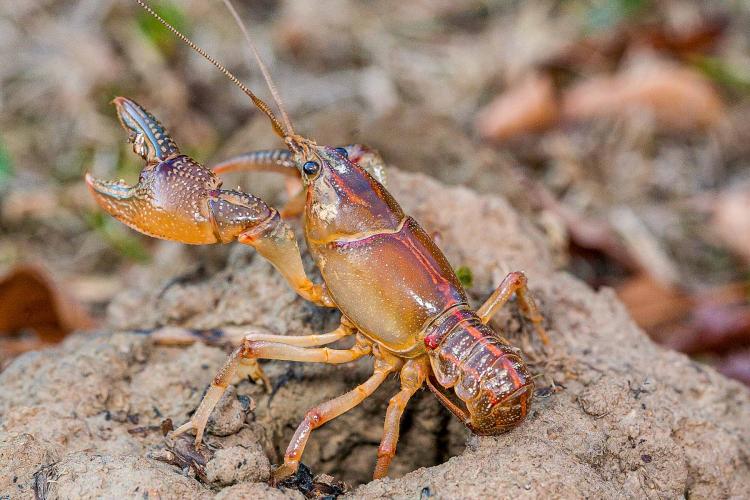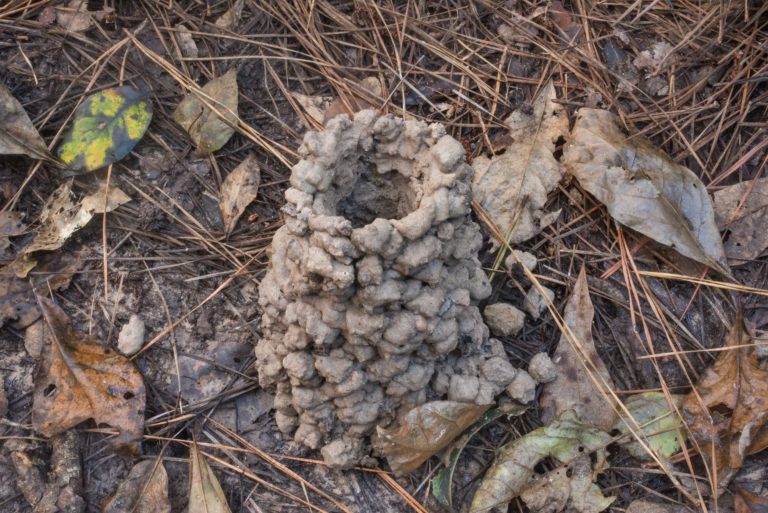Crayfish
Crayfish are feisty little ecosystem engineers that sometimes make their homes away from water. They’re expert diggers, seek out drug-induced highs, and are great models for anxiety. Learn more about the humble crayfish, crawdad, mudpuppy, yabby, or whatever nickname you might have for them, below.
Main Notes and Takeaways
- Small but mighty, crayfish are considered ecosystem engineers due to how they shape the environment around them (more below).
- Though we associate them with streams and lakes, crayfish can be found in the middle of grasslands even where only temporary water sources appear in spring.
- They molt twice a year as adults, entering a reproduce phase and non-reproductive phase as they do so.
- Weird crayfish studies:
- They actively seek out drugs, and react surprisingly similarly to humans to cocaine, meth, and more.
- They experience anxiety, and when given anti-anxiety meds are significantly calmed (more below).
- When exposed to certain herbicides its been shown that burrowing activity increases which can impact stream banks.

Our Favorite Notes from This Episode
Crayfish: Ecosystem Engineers
Crayfish come in not only a surprising number of colors, patterns, shapes and sizes, but also differ wildly in their burrowing activity. While many people may be familiar with crayfish “chimneys” made up of the excavated dirt, very few people know what is going on underground. Some crayfish (often called primary burrowers) dig a lot and can have tunnels 15 feet (3.5 m) long. Others, called secondary burrowers, live closer to streams, rivers, and lakes and may even have a few tunnels underground leading to the water. Tertiary burrowers are the final group of crayfish, and often don’t burrow at all. Instead, they will usually live entirely in a source of water and hide in vegetation or under rocks.
All three group of crayfish are known as ecosystem engineers due to the impact they have on their environment. Crayfish not only are very important decomposers of both plant matter and flesh, but all their burrowing also helps recycle nutrients. Crayfish can be found in the middle of grasslands with no permanent water source nearby and have to create deep, often complex, tunnels to keep hydrated. These tunnels aerate the soil, bring nutrients to the surface to help plants, and also bring water down into the soil.

Crayfish as Models of Anxiety
When we think of anxiety, we don’t often think of crayfish, but in recent years there have been several experiments looking at how these little invertebrates experience emotion. One study found that crayfish will actively avoid areas where they were exposed to negative experiences. These same crayfish when given anti-anxiety medication would wander the tanks freely, seemingly unworried.
Another study looked at crayfish hierarchy. Dominate crayfish that won fights would actively be aggressive against other crayfish and even their own reflections. Subordinate crayfish who lost fights would avoid their reflections and walk backwards to keep an eye on other crayfish. It’s also been found that crayfish who fall into an insubordinate or dominate category often stay that way. Winners stay winners, losers stay losers. The twist however, was that if the winners were exposed to electrical shocks the anxiety of this event made them forget they were previously winners and made them more likely to lose. We know anxiety can have extremely detrimental effects to humans and it seems crayfish may function somewhat similarly.
Sources/Further Reading:
- Florey, C. 2019. Description of Burrow Structure for Four Crayfish Species [Master’s thesis, Bowling Green State University]. OhioLINK Electronic Theses and Dissertations Center.
- Fossat, P., Bacque-Cazenave, J., et al. 2014. Anxiety-like behavior in crayfish is controlled by serotonin. Science 344(6189): 1293-1297.
- Kamada S, Nagayama T. 2021. Anxiety induces long-term memory forgetting in the crayfish. J Comp Physiol A Neuroethol Sens Neural Behav Physiol 207(4):459-467. doi: 10.1007/s00359-021-01487-1.
- Mercier AJ, May HY. 2010. Recording behavioral responses to reflection in crayfish. Journal of Visualized Experiments (39):1956. doi: 10.3791/1956.
- Huber, R., Imeh-Nathaniel, A., Nathaniel, T., et al. 2018. Drug-sensitive Reward in Crayfish: Exploring the Neural Basis of Addiction with Automated Learning Paradigms.
- Guo W, Weiperth A, Hossain MS, Kubec J, Grabicová K, Ložek F, Veselý L, Bláha M, Buřič M, Kouba A, Velíšek J. 2021. The effects of the herbicides terbuthylazine and metazachlor at environmental concentration on the burrowing behaviour of red swamp crayfish. Chemosphere 270:128656. doi: 10.1016/j.chemosphere.2020.128656.
- Barbaresi S, Tricarico E, Gherardi F. 2004. Factors inducing the intense burrowing activity of the red-swamp crayfish, Procambarus clarkii, an invasive species. Naturwissenschaften 91(7):342-5. doi: 10.1007/s00114-004-0533-9.
- Dasho, I., and DiStefano, B. 2020. Burrowing Crayfish. Missouri Department of Conservation.
- Loughman Lab Facebook page. West Liberty University.
Did you spot an error or have questions about this post? Email Nicole Brown.
